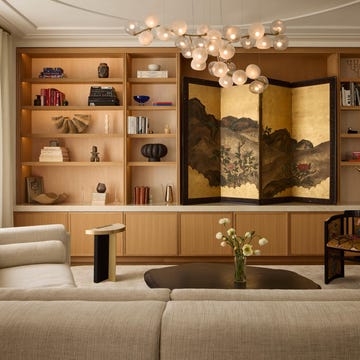A north-Londoner born and bred, Philip Hooper found the thought of moving south of the river anathema. It was an apartment in a converted Victorian school that changed his mind, appealing to the interior designer’s architectural training. ‘You bought the shell – a big white box with some electrics and water – and did your own fit out,’ he says.
‘David Linley had one; so did Kelly Hoppen. People in the decorating world gravitated towards them because they wanted a loft space to put their stamp on without the confines of a London townhouse apartment or mansion flat.’ That was 25 years ago – the most time that Philip has ever lived in one place, and almost as long as he’s worked at Sibyl Colefax & John Fowler (Britain’s longest-established decorating firm that’s shaped tastes since the 1930s), where he is joint managing director with Emma Burns.
Keen to preserve the schoolroom’s lofty proportions, Philip compromised on floor space, incorporating a mezzanine into the open-plan volume, where his bedroom, bathroom and a small second seating area can be found. The main living room, study, dining nook and kitchen are all on the lower level.
What's everyone reading?
Unlike his Georgian country house (a space demanding a period-appropriate approach), Philip’s city pied-à-terre allowed him to decorate in an ‘incredibly selfish’ way. When he bought it, ‘modernity’ meant empty, but he wanted his collection of art and furniture to sing against a colourful background. ‘I was trying to say, “You don’t need to live in an art gallery”,’ he explains.
While his home has evolved over the years, with objects passing through, a few beloved pieces (a desk, lamp and cabinet) have remained as a ‘fulcrum’ to build around. Many pictures are propped up rather than fixed to walls, offering a liberating fluidity that allows Philip to see old friends in a new light. ‘I brought back black and white photographs from the country house. It’s nice to live with those again, rather than them being tucked down a corridor and not looked at,’ he says.
He is fond of the ochre wall: the perfect foil to a brutalist Belgian cupboard with an Andy Warhol above it. ‘On top of the cupboard is a collection of things that come and go. It’s like a three-dimensional storyboard of my career,’ he explains.
That career began with a decision to study architecture at art school in Canterbury: ‘I thought it was the perfect place to rebel!’ He wanted to secure a placement in Richard Rogers’ office, but his tutors steered him towards an interior-decorating firm instead, where he found himself sitting next to David Chipperfield.
He enjoyed the immediacy of the discipline so much that he decided not to return to his course and went on to work under John Stefanidis, who showed him ‘how architecture and design are inseparable’. He set up his own practice and joined Sibyl Colefax & John Fowler in 2001.
For Philip, comfort should drive design, whether it’s an 18th-century country house or a ski lodge. ‘It’s having somewhere to put your feet up and put a drink down, and the right light,’ he says. Equally important is having the confidence to make it personal. ‘If you surround yourself with things you love, your DNA binds them and gives them harmony. Don’t listen to other people. If you like it, have it.’
Proof of his philosophy is the hand-blocked Mauny wallpaper in this home. ‘It gives me huge pleasure,’ he says, admitting to a partial responsibility for driving the trend for feature walls – ‘I have to put my hand up for that one!’
There’s nothing particularly ‘London’ about Philip’s bolthole, but it does have ‘an eccentricity that’s undoubtedly English’, he says. ‘That slightly oblique way of looking at things is consistent with my work.’ This quality can be seen in his designs, including a chalet in the Rocky Mountains (‘a departure from what’s expected from the oldest decorating firm in the world’) and an artist’s studio in Chelsea.
Next, he’ll be adding his signature ‘layer of humanity’ to a project in Little Venice, placing ‘old against new, against texture, flat colour, pattern. It’s about how these things talk to one another’. There’s also more work to be done in Chelsea for a young couple. ‘This generation wants to revisit how their grandparents lived and surround themselves with nostalgia and comfort,’ he explains. ‘They’re looking for a modern version of what Colefax might have done 50, 60 years ago. Everything’s a cycle.’
Philip’s London base is a sanctuary, where he loves to retreat with just his dog Oscar for company (‘I can probably count on one hand the number of dinner parties I’ve had’), and a source of inspiration. While everything is in a state of flux, the theories tested out here have proved sound. ‘Everything we do now is similar to what I did all that time ago. It’s about making a comfortable, modern space that isn’t sterile.’ sibylcolefax.com
This home features in All Things Considered by Emilio Pimentel-Reid (Hardie Grant Books, £35)


















